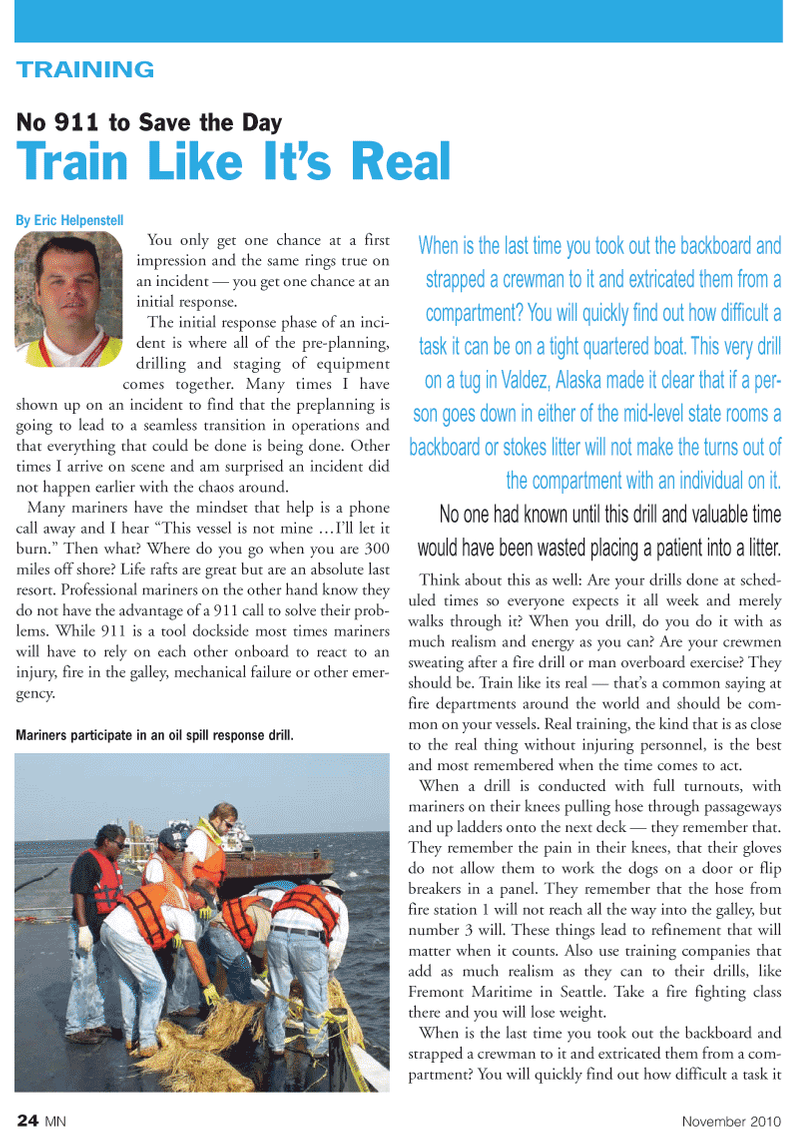
Page 24: of Marine News Magazine (November 2010)
Workboat Annual
Read this page in Pdf, Flash or Html5 edition of November 2010 Marine News Magazine
24 MN November 2010
TRAINING
You only get one chance at a first impression and the same rings true on an incident — you get one chance at an initial response.
The initial response phase of an inci- dent is where all of the pre-planning, drilling and staging of equipment comes together. Many times I have shown up on an incident to find that the preplanning is going to lead to a seamless transition in operations and that everything that could be done is being done. Other times I arrive on scene and am surprised an incident did not happen earlier with the chaos around.
Many mariners have the mindset that help is a phone call away and I hear “This vessel is not mine … I’ll let it burn.” Then what? Where do you go when you are 300 miles off shore? Life rafts are great but are an absolute last resort. Professional mariners on the other hand know they do not have the advantage of a 911 call to solve their prob- lems. While 911 is a tool dockside most times mariners will have to rely on each other onboard to react to an injury, fire in the galley, mechanical failure or other emer- gency.
Think about this as well: Are your drills done at sched- uled times so everyone expects it all week and merely walks through it? When you drill, do you do it with as much realism and energy as you can? Are your crewmen sweating after a fire drill or man overboard exercise? They should be. Train like its real — that’s a common saying at fire departments around the world and should be com- mon on your vessels. Real training, the kind that is as close to the real thing without injuring personnel, is the best and most remembered when the time comes to act.
When a drill is conducted with full turnouts, with mariners on their knees pulling hose through passageways and up ladders onto the next deck — they remember that.
They remember the pain in their knees, that their gloves do not allow them to work the dogs on a door or flip breakers in a panel. They remember that the hose from fire station 1 will not reach all the way into the galley, but number 3 will. These things lead to refinement that will matter when it counts. Also use training companies that add as much realism as they can to their drills, like
Fremont Maritime in Seattle. Take a fire fighting class there and you will lose weight.
When is the last time you took out the backboard and strapped a crewman to it and extricated them from a com- partment? You will quickly find out how difficult a task it
No 911 to Save the Day
Train Like It’s Real
By Eric Helpenstell
When is the last time you took out the backboard and strapped a crewman to it and extricated them from a compartment? You will quickly find out how difficult a task it can be on a tight quartered boat. This very drill on a tug in Valdez, Alaska made it clear that if a per- son goes down in either of the mid-level state rooms a backboard or stokes litter will not make the turns out of the compartment with an individual on it.
No one had known until this drill and valuable time would have been wasted placing a patient into a litter.
Mariners participate in an oil spill response drill.

 23
23

 25
25
